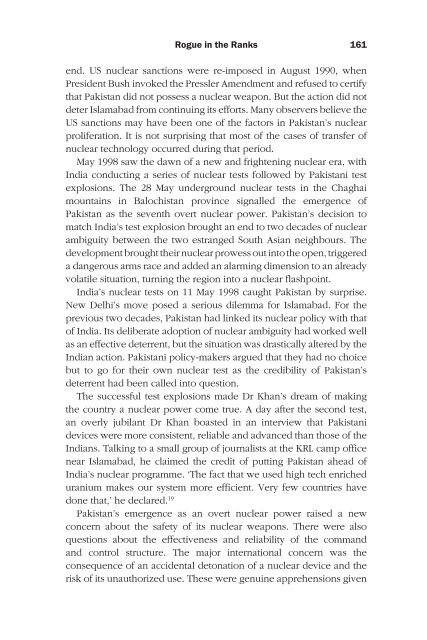Frontline Pakistan : The Struggle With Militant Islam - Arz-e-Pak
Frontline Pakistan : The Struggle With Militant Islam - Arz-e-Pak
Frontline Pakistan : The Struggle With Militant Islam - Arz-e-Pak
Create successful ePaper yourself
Turn your PDF publications into a flip-book with our unique Google optimized e-Paper software.
Rogue in the Ranks<br />
1 1<br />
end. US nuclear sanctions were re-imposed in August 1990, when<br />
President Bush invoked the Pressler Amendment and refused to certify<br />
that <strong><strong>Pak</strong>istan</strong> did not possess a nuclear weapon. But the action did not<br />
deter <strong>Islam</strong>abad from continuing its efforts. Many observers believe the<br />
US sanctions may have been one of the factors in <strong><strong>Pak</strong>istan</strong>’s nuclear<br />
proliferation. It is not surprising that most of the cases of transfer of<br />
nuclear technology occurred during that period.<br />
May 1998 saw the dawn of a new and frightening nuclear era, with<br />
India conducting a series of nuclear tests followed by <strong><strong>Pak</strong>istan</strong>i test<br />
explosions. <strong>The</strong> 28 May underground nuclear tests in the Chaghai<br />
mountains in Balochistan province signalled the emergence of<br />
<strong><strong>Pak</strong>istan</strong> as the seventh overt nuclear power. <strong><strong>Pak</strong>istan</strong>’s decision to<br />
match India’s test explosion brought an end to two decades of nuclear<br />
ambiguity between the two estranged South Asian neighbours. <strong>The</strong><br />
development brought their nuclear prowess out into the open, triggered<br />
a dangerous arms race and added an alarming dimension to an already<br />
volatile situation, turning the region into a nuclear flashpoint.<br />
India’s nuclear tests on 11 May 1998 caught <strong><strong>Pak</strong>istan</strong> by surprise.<br />
New Delhi’s move posed a serious dilemma for <strong>Islam</strong>abad. For the<br />
previous two decades, <strong><strong>Pak</strong>istan</strong> had linked its nuclear policy with that<br />
of India. Its deliberate adoption of nuclear ambiguity had worked well<br />
as an effective deterrent, but the situation was drastically altered by the<br />
Indian action. <strong><strong>Pak</strong>istan</strong>i policy-makers argued that they had no choice<br />
but to go for their own nuclear test as the credibility of <strong><strong>Pak</strong>istan</strong>’s<br />
deterrent had been called into question.<br />
<strong>The</strong> successful test explosions made Dr Khan’s dream of making<br />
the country a nuclear power come true. A day after the second test,<br />
an overly jubilant Dr Khan boasted in an interview that <strong><strong>Pak</strong>istan</strong>i<br />
devices were more consistent, reliable and advanced than those of the<br />
Indians. Talking to a small group of journalists at the KRL camp office<br />
near <strong>Islam</strong>abad, he claimed the credit of putting <strong><strong>Pak</strong>istan</strong> ahead of<br />
India’s nuclear programme. ‘<strong>The</strong> fact that we used high tech enriched<br />
uranium makes our system more efficient. Very few countries have<br />
done that,’ he declared. 19<br />
<strong><strong>Pak</strong>istan</strong>’s emergence as an overt nuclear power raised a new<br />
concern about the safety of its nuclear weapons. <strong>The</strong>re were also<br />
questions about the effectiveness and reliability of the command<br />
and control structure. <strong>The</strong> major international concern was the<br />
consequence of an accidental detonation of a nuclear device and the<br />
risk of its unauthorized use. <strong>The</strong>se were genuine apprehensions given













